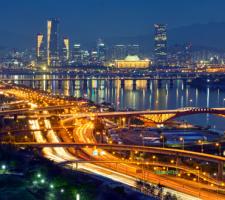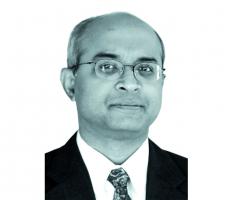
Two megatrends are posing unprecedented challenges to those trying to keep people moving around the world’s urban areas now - and in the years and decades to come. The first is rapid urbanisation. One in six of us lived in urban areas at the turn of the 20th century. At the end of it, that figure was three in six - and by 2050 it will be four in six. The second trend is growing affluence. According to US thinktank Brookings, more than half the world’s population is now officially middle class.
The implications are clear. Many more of us are cramming into closer quarters and have the money to start to exercise choice about how we get around. What proportion might opt for the automobile as their first choice - and if so to what extent should its use be accommodated and in what circumstances?
This is a question taken up by Dr Venkat Sumantran, chairman of consultant Celeris Technologies, MISI adjunct professor at
The first challenge to tackle is a proper recognition of the problems, says Sumantran. “We felt people were missing the question we should be trying to answer. Densification is something that is happening and I don’t think sometimes we are seeing it. As population and densification increase the mobility architecture has to change.”
Recognising the urgency of the need to achieve more sustainable mobility - given the emergency of poor air quality and its resulting social costs - is another problem that must be given greater thought.
Pressing problem
It is a pressing problem in even the most developed and regulated markets such as Europe, let alone in cities such as Mumbai, Beijing or Lagos, says Sumantran. “We have Euro 6 vehicles becoming common but we are still being confronted with air quality issues.”
The book does not prescribe specific solutions given the widely varying needs of cities, he explains; rather, its aim is to provide a coherent framework within which any urban area can work. “What LA needs is different to what London needs,” he says.
Technology comprises an important component of the model. “The possibilities that have been unleashed by technology have been amazing in our digitally-connected society,” says Sumantran. “Just look at the incredible tools from our smartphones. The way we can assemble mobility has phenomenally expanded. Then there is the whole idea of the sharing economy, access to information, the ride-hailing process, key wallets that allow seamless money transactions.
All these put together start to create new mobility solutions.”
While the exact nature and mix of answers may be different depending on the context, all successful solutions will have some common features. The new urban mobility architecture must first of all be heterogenous, he says.
“We are evolving and must encourage the further evolution of a diversity of mobility modes from ride-hailing to smart cars, micro cars, shared vans and so on. We need that full portfolio of solutions available to us that will enable city regulators to build a range of solutions and arrange them differently by city.”
This heterogenous approach should aim to exploit the advantages of all modes of transport. “We have not fully leveraged the full set of solutions including pedestrian or bike highways, microcars or scooters. The bottom line is we need to encourage diversity,” says Sumantran.
The specific mix will vary. In low-density cities, for example private, dynamically routed minibuses could complement existing bus routes or they could offer part of the last mile solution joining commuters to the main road or rail commuting options. In higher density cities other solutions will come to the fore: “Some cities may have need of a van pool, some will get by with Uber Pool.”
Building blocks
Connecting these mobility building blocks is the next challenge. “You will only move people from their cars to more multimodal solutions when the connections are seamless,” says Sumantran. “You should be able to use the bus, train or the car when they make sense. Connectivity is crucial in making multimode journeys work.”
This will, in part, come down to the quality of the physical infrastructure that builds in different options, exemplified in places such as Frankfurt airport. “Within 15 minutes of having stepped off the aircraft I have a choice of high speed inter-city rail, local metro services, cars and bikes,” says Sumantran.
Connectivity also includes the digital infrastructure that can blend all these modes together in different combinations, he says. “The digital element of connectivity is becoming established enabling travellers to use a hire car for four hours, for example. These are the elements that make travel across segments and geographies possible.”
Intelligent systems will form vital layers in this smart mobility architecture. Sumantran identifies three layers: the individual layer on smartphones and home artificial intelligence (AI) such as Alexa or Google Home; the increasingly smart technology in cars, buses and trains; and the smart infrastructure being wired into the fabric of cities themselves, providing new data streams.
The final element of the mobility architecture is the ability to personalise it, says Sumantran. “Maybe I want a low carbon journey or I want to prioritise based on affordability or privacy. You have to be able to synthesise solutions based on these criteria so you can optimise your journey.”
The challenge is how to make this all actually happen.
Since writing the book, Sumantran has come to view policy making as the factor that will be decisive in the rollout (or not) of this new architecture. Policy must somehow find a way to respond to a fast-shifting set of problems and potential solutions.
The challenges posed by rapid innovations such as ride-share or, most recently, the appearance almost overnight of electric scooter operators, are clear examples. While they offer new mobility solutions they are so new and disruptive there is no rulebook in many cases.
“We must keep in mind all the consequences of new technology and leverage it, while as far as possible avoiding the adverse effects,” he suggests. “Policy makers and regulators need to take a more dynamic role and not run away from technological solutions and instead be able to change the contours of policy to embrace them.”
Slow response
So far regulators’ and legislators’ speed of response has been too slow, he notes. “In most democracies the clock speed of regulation and policies is very slow, slower than the progress of technology. Singapore and Seoul are two rare examples of city authorities that are able to respond readily and effectively.”
Perhaps the greatest challenge facing those who would seek to build this new mobility architecture is the fact that investment in intelligent systems at a city level remains far below where it should be, Sumantran laments.
“We have dealt with 40-50 cities in the book and we found by and large that the average city across the globe is woefully behind times in terms of getting to grips with technology. For all the talk of smart cities in most parts of the world investment in information significantly lags the organic expansion or development of an economy or society. Those who have deployed a system and who are leveraging their data are rare. It is more hype than reality.”
Part of the solution lies in selling the benefits of such investment in mobility innovation to citizens. “We have done a poor job of educating the public about the benefits. We need to gain public support for what we are doing,” says Sumantran. “It is a tough job communicating the value of certain things such as the value of a parking space, a bench, a tree or a sidewalk area - but opening up the conversation about the relative merits to which public spaces can be put, how appropriately they are being used and who is paying or not paying for them is important.”
Engaging in a more thoughtful approach to what really matters can help overcome misconceptions about what is achievable, he adds. “I was speaking to a former transport commissioner of New York City who said people would rebel against any London-style congestion charge there and I asked why: 90% of New Yorkers commute by public transit, what would their problem be? We have not conveyed the pros and cons of what are public assets well enough.”
Without overcoming this business-as-usual inertia little progress can be made on developing the policy and pricing nudges that will induce citizens to try new options. People opt to own cars for their anticipated uses - not the day to day reality of their use, for example - but with convenient options this can change.
Sumantran concludes: “If it is easy and painless for me to get and drop off a four-wheel drive vehicle for three days of the year, for example, all of a sudden this could make me see that my potential needs can be met by temporary services that cost less and have less environmental impact.”














